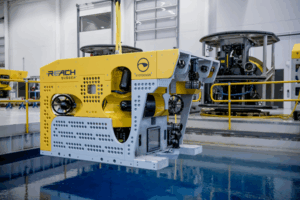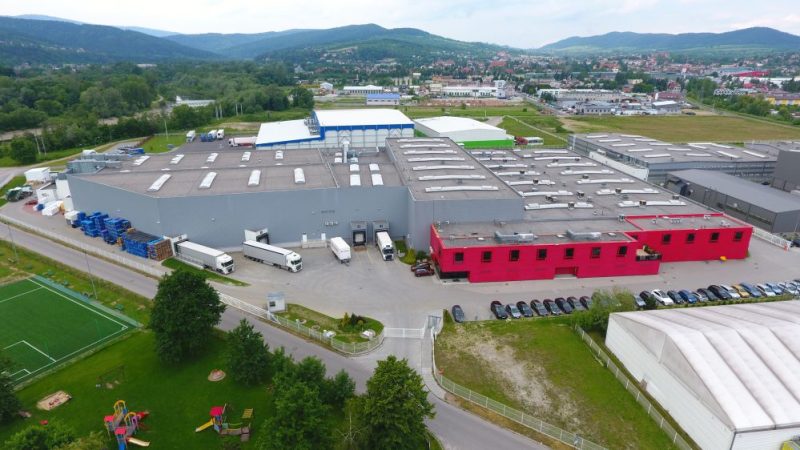Every business wants new efficiencies and ways to economise, and the marine sector is no exception. When you look for the biggest costs on any ocean-going vessel, there is one that stands out among all others.
“There are a lot of costs to having people on board, so if you can remove them, it becomes much more cost efficient. The vessel is smaller to build and it is not as heavy an investment as a conventional vessel,” points out Bjørg Mathisen Døving, Vice-President of Reach Subsea.
Reach Subsea is a listed company established in 2008 with a focus on marine subsea operations. The firm has its own fleet of remotely operated vehicles, as well as specialised crew and project management capabilities. The company also has its own portfolio of vessels, with some owned and some chartered, up to 100 metres in length.
With 500 employees worldwide, Reach Subsea has offices in Haugesund in Norway, Houston in the USA, Rio de Janeiro in Brazil, Aberdeen in Scotland and Perth, Australia. The company specialises in ocean data, it installs its own ROV systems, building a platform from which to execute complex subsea marine projects.
As well as creating a huge cost efficiency by having the crew operating the vessel remotely, Reach Subsea’s remote solutions also open up opportunities for talent deployment.
“Specialist crew can stay on shore rather than being hostages of the vessel,” Døving explains. “They can be remotely deployed as needed to any vessel out there.”
This is a particular boon at a time when the maritime industry worldwide does not have enough crew to accommodate the vessels that are already sailing. It also provides an environmental boon, with smaller vessels able to do larger tasks with less fuel consumption. This causes a noted reduction in emissions all by itself, and that is before you take into account the emissions created moving crew to and from the ship in the first place.
“With remote vessels, you don’t need to include the services to support the people,” Døving points out. “That means no galley, no fresh water, no lighting or cabins. So we see a shift toward remote and autonomous technologies that will also make ships cheaper to build.”
Finally, no crew means no crew in hazardous marine environments, no crew at risk, and no dangerous accidents.
Extending Their Reach
It is a compelling case, but Reach Subsea is taking it a step further with Reach Remote, an innovative new uncrewed 24-metre-long ROV and survey vessel that is going to dramatically disrupt the industry.

“The purpose of the vessel is to transport the ROV to its destination and supply the ROV with power so it can be deployed remotely over-the-horizon and execute the work,” Døving tells us.
This unique approach to delivery is being developed alongside Kongsberg Maritime, the prime contractor on the vessel’s development. Kongsberg is responsible for selecting and managing the yard for the new vessel, as well as coordinating its supply chain, systems integration and commissioning. Kongsberg is also responsible for designing to vessel, ensuring that Reach Remote is a true turnkey project.
“Reach Subsea has big plans for these vessels and wants to scale up, so we need to manage this in a way that can meet their expectations,” says Kongsberg Maritime’s Project Manager, Marthe Kristine Sand.
“We were looking at a smarter way to do subsea operations,” Døving says. “We are continuing our conventional operations for complex projects, but for straightforward ROV and survey operations Reach Remote provides a solution.”
Where a conventional vessel doing this sort of work would require 50 people, including project and specialist crew, with each of those people adding to costs and emissions, Reach Remote allows those specialists to work remotely from the shore. Over the years Reach Subsea has established that teams can remotely navigate vehicles from over the horizon. Reach Remote, devised by Kongsberg Maritime with a down-scaled prototype partly funded by the Norwegian government, widens those possibilities still further.
“This project represents a real step-change in the drive for efficient and safer offshore operations,” says Sand. “What’s different about Reach is that it will operate without crew, from day one. They will be carrying out duties that are typically done by much larger vessels, with large crew numbers. There are major cost advantages, in terms of crew and fuel consumption.”
A Joint Venture
To realise the possibilities of its new remote vehicle, Kongsberg Maritime has partnered with Reach Subsea due to the company’s proven track record and specialism in remote vehicles. Reach Subsea’s contributions to the project have included studies into cyber security threats and establishing technical design criteria.
“Throughout the process, we took the best from both of our organisations,” Døving tells us. “We designed a vessel with a steel hull, able to withstand Norwegian winter waters and operate in high waves for durations of 30 days offshore. It has twin skates for stability and two propellors, front and back. The ship is designed to be lifted and transported by another vessel, so it does not need to sail long distances on its own, and it has no bridge because none is needed.”
What it does have is a moon pool, situated directly between the vessel’s twin skates, to allow a subsea ROV to be deployed on-site.

Once deployed, the vessels will be monitored from an ROC in Horten, and followed by a support vessel in the early stages of its operation. This monitoring will be the work of Massterly, a joint venture between Kongsberg Maritime and ship management firm, Wilhelmsen.
“Increased remote and autonomous functionality will be gradually introduced in a stepwise approach pending technology readiness,” Sand tells us. “Reliability of onboard systems is critical to the success of this type of operation, particularly as the vessels are designed to have a 30-day operational window. That means they could be out on their own in the North Sea for 30 days. That’s an unthinkable concept today, so we’ve selected proven technology.”
As well as being a feat of engineering, Reach Remote also has regulatory challenges to overcome. Or rather, a lack of regulations.
“There are no rules and regulations from the International Maritime Organisation on uncrewed vessels, so I believe we have established a very good path in Norway with this joint Norwegian cooperation,” says Døving. “We are working closely with Norwegian maritime authorities and hope this project will be a lighthouse for the industry, pushing the IMO in the direction of establishing codes and standards for uncrewed vessels.”
Those codes and standards will be even more important as the industry transitions towards net zero. Reach Remote’s model sets a new industry standard for low-carbon, high-efficiency subsea operations, while the integration of remote operations with sustainability will ensure a future-ready, environmentally responsible offshore sector. It represents a solution Døving hopes to see operating around the world.
“Reach Subsea together with Massterly and Kongsberg Marine rely on each other in our strategy,” Døving tells us. “We were established in Norway and have been focusing on the North Sea, but because of the weather conditions here, we are well positioned to establish our services worldwide. We believe Reach Remote is a new disruptive technology that can open up international opportunities. We are the first in the world to deploy a totally uncrewed ROV and survey vessel of this size. The Reach Remote will be a catalyst for worldwide market penetration.”






